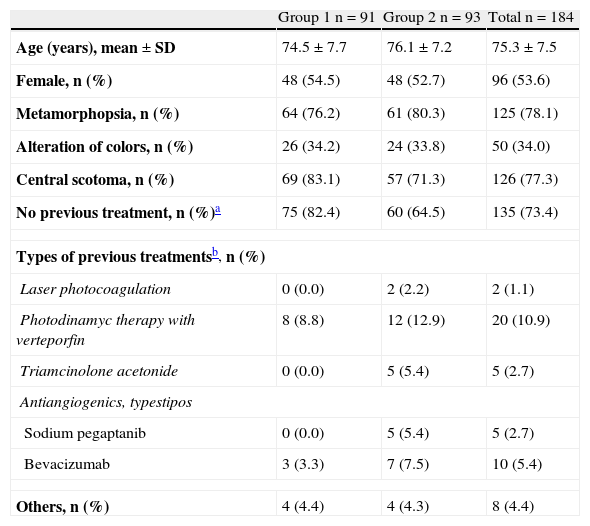To assess the mean best-corrected visual acuity (BCVA) change in patients with exudative-hemorrhagic age-related macular degeneration (EH-ARMD) after 12-month period of treatment with ranibizumab.
MethodsA retrospective, multicentre and national study of intravitreal administered ranibizumab was conducted on two groups of EH-ARMD patients: only one eye affected (group 1) vs second eye affected (group 2), having the first one affected.
Eligible subjects were ≥50 years old with primary or secondary active subfoveal EH-ARMD-related choroidal neovascularisation (CNV).
ResultsA total of 184 patients (91 group 1 and 93 group 2) were included. Mean age (SD) was 75.3 (7.5) years, and 53.6% were women. The BCVA showed a VA improvement at 12 months of 9.3 (18.0) number of letters in group 1 and 5.1 (16.8) number of letters in group 2 (p<0.0001 and p=0.0042, respectively). No statistical differences between groups were observed. Lesion characteristics in the total population (baseline vs 12-month) were: drusen (69.1% vs 61.1%), macular hemorrhages (59.0% vs 7.3%), lipid exudates (28.1% vs 8.2%), and retinal pigment epithelium detachment (46.8% vs 19.0%). The optical coherence tomography (OCT) in the total population (baseline vs 12-month) showed a reduction in macular edema (73.6% vs 20.9%), subretinal fluids (71.3% vs 14.7%), and intraretinal cysts (38.5% vs 19.7%), as well as a reduction of the mean foveal thickness 377.4±109.8μm vs 249.1±67.8μm in group 1 and 354.1±123.2μm vs 254.6±67.4μm in group 2, p<0.0001, both groups, with no significant differences between groups.
ConclusionsIntravitreal administration of ranibizumab for a minimum of 12-months significantly improved the BCVA, decreased lesion characteristics, and reduced the initial mean foveal thickness in patients with CNV primary or secondary to EH-ARMD, both in patients with only one eye affected and in patients with a second eye affected, having the first one affected.
Evaluar el cambio medio de la mejor agudeza visual corregida (MAVC) en pacientes con DMAE exudativa-hemorrágica (DMAE-EH) a los 12-meses de tratamiento con ranibizumab.
MétodosEstudio observacional, retrospectivo, multicéntrico y nacional, en dos grupos de pacientes con DMAE-EH: primer ojo afectado (grupo 1) y segundo ojo afectado (grupo 2), teniendo afectado el primer ojo.
Se incluyeron pacientes ≥50 años, diagnosticados de neovascularización coroidea subfoveal activa principal o recurrente secundaria a DMAE-EH.
ResultadosSe incluyeron 184 pacientes (91 grupo 1 y 93 grupo 2), edad media±DE de 75,3±7,5 años y 53,6% mujeres. La MAVC mostró una mejoría de la AV a los 12-meses: 9,3±18,0 número de letras grupo 1 y 5,1±16,8 número de letras grupo 2 (p<0,0001 y p=0,0042, respectivamente), sin observarse diferencias significativas (NS) entre ambos grupos. Las lesiones retinianas en la población total (basal vs 12-meses) fueron: drusas (69,1% vs 61,1%), hemorragias maculares (59,0% vs 7,3%), exudados lipídicos (28,1% vs 8,2%) y desprendimiento del epitelio pigmentario (46,8% vs 19,0%). Los resultados de la OCT en la población total (basal vs 12-meses) mostraron una reducción del edema macular (73,6% vs 20,9%), del fluido subrretiniano (71,3% vs 14,7%) y de quistes intrarretinianos (38,5% vs 19,7%), así como una reducción del grosor foveal medio de 377,4±109,8μm vs 249,1±67,8μm grupo 1 y 354,1±123,2μm vs 254,6±67,4μm grupo 2, p<0,0001, ambos grupos, sin observarse diferencias significativas entre ambos grupos.
ConclusionesLa administración de ranibizumab intravítreo durante un mínimo de 12-meses conllevó una mejoría significativa en la MAVC, una disminución de las lesiones retinianas y una disminución del grosor retiniano medio inicial en pacientes con NVC principal o secundaria a DMAE E-H, tanto en los pacientes con primer ojo afectado como en los pacientes con segundo ojo afectado, teniendo afectado el primero.
Artículo
Comprando el artículo el PDF del mismo podrá ser descargado
Precio 19,34 €
Comprar ahora











